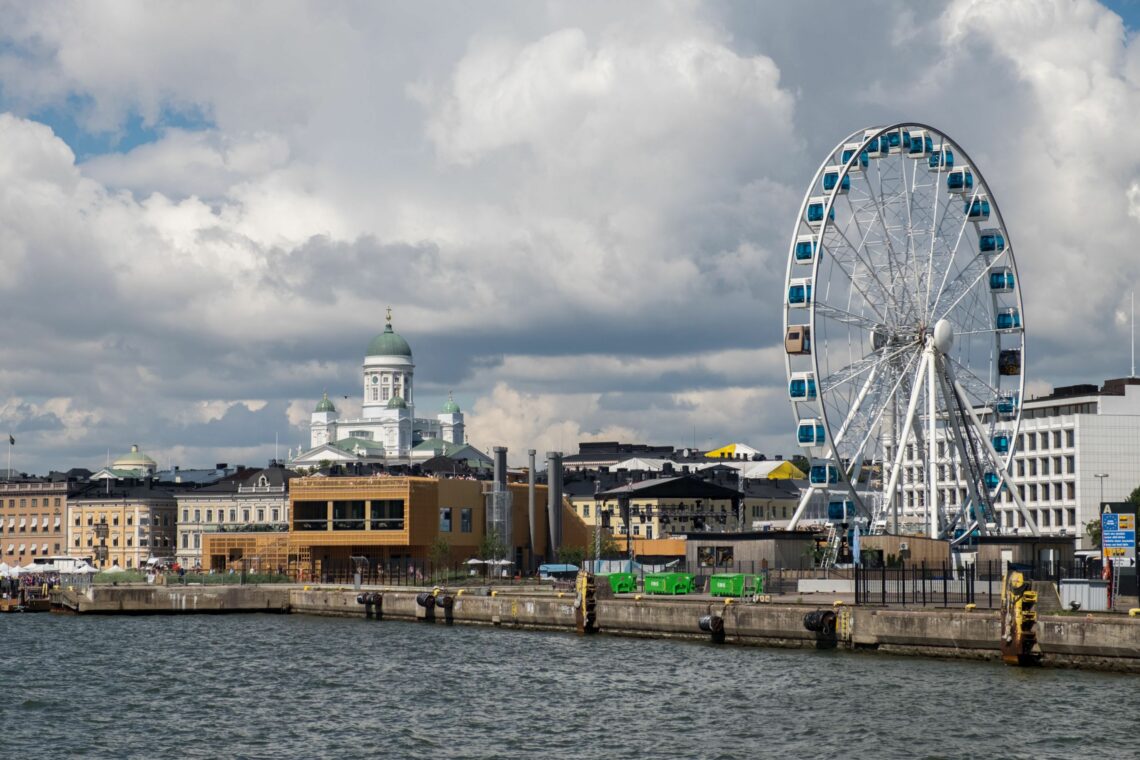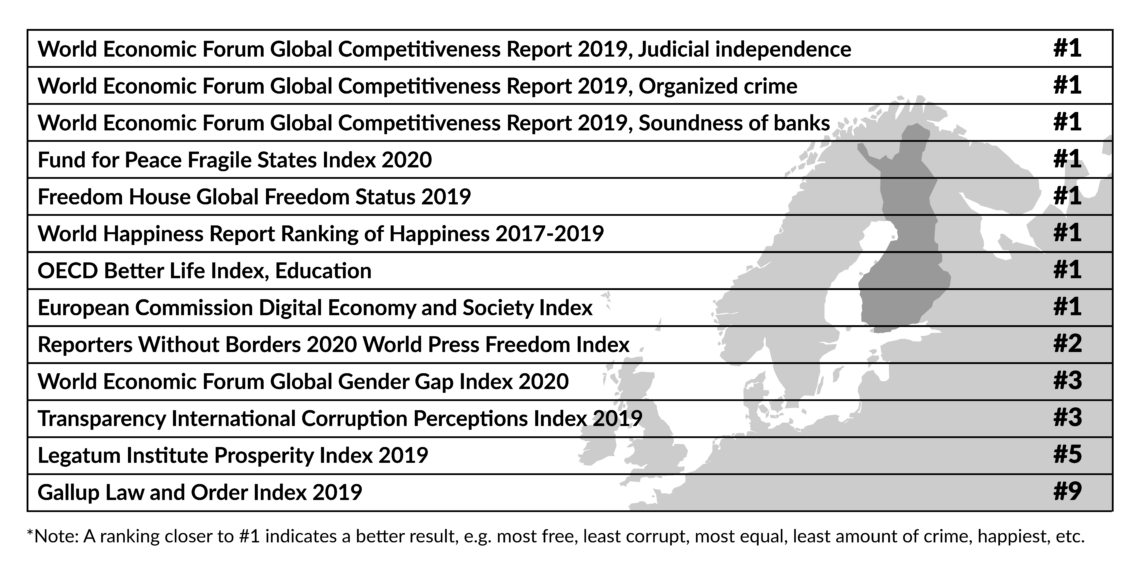Finland: On top of the world, but for how long?
Finland ranks at the top of international lists for good governance and democracy. However, it faces a demographic challenge. Having to increase immigration tenfold would challenge the very cohesiveness that has helped Finland build its resilience.

In a nutshell
- Finland has become an international success story
- National cohesion has helped it achieve this status
- A demographic crisis may force unwanted change
Finland earned respect internationally for how it managed relations with the Soviet Union during the Cold War. Operating under a constant threat of sanctions and aggression, successive Finnish governments not only safeguarded national independence, they also developed the fundamental institutions for democracy and a market economy.
The outcome has been to make Finland one of the highest-achieving countries in the world. It routinely scores among the top five in international rankings on matters ranging from democracy, governance and freedom of speech, to prosperity, social justice, personal safety, the rule of law, corruption and protection of property rights. It also does well in rankings for more subjective indicators such as which country is the best to live in.
An important reason why these various achievements have received so little attention is that grandstanding about its own accomplishments, or moaning about perceived slights, is not the Finnish way. Rain or shine, Helsinki tends to go about its business with quiet, self-reliant determination.
Facts & figures

Finland’s path to success
In December 2018, Statistics Finland, the national statistics bureau, opted to celebrate the centenary of independence from the Russian Empire by compiling a rather long list of top scores in international rankings, titled “Finland among the best in the world.”
Finland is certainly not alone in performing well. Other countries that tend to be in the top five in international rankings are Denmark, Singapore and New Zealand. While they share a common record of success, there are also key features that set them apart, ranging from their location and natural resources to softer variables like language and historical legacies. Yet even in cases where achievements are similar, the paths leading to those achievements may have been quite different, implying that relative strengths and weaknesses will also be different.
The border between Finland and Russia represents one of the sharpest divides between wealth and poverty in the world.
A formative experience for Finland was its defense against Soviet aggression during the Winter War in 1939-40. If Finland had lost that war, it would have been incorporated into the USSR as one more Soviet Republic. Moscow had groomed Finnish communist Otto Wille Kuusinen for the task of leading that entity. By the end of the Cold War, the country would have been in a situation like that of its southern neighbor, Estonia – economically and technologically backward, shut off from the rest of the (non-communist) world.
As things stand today, the border between Finland and Russia represents one of the sharpest divides between wealth and poverty in the world.
The collective memory of present-day Finns recalls that the battle to preserve independence was both costly and closely fought. The war resulted in around 70,000 casualties on the Finnish side. At times it was touch and go if critical defenses would hold.
Finland was left to fight its Winter War alone. Despite a long common history, Sweden proclaimed neutrality. The failure of Finland’s neighbor to come to its aid left a festering sore in relations and brought home to Finns that they must be ready to face future crises by themselves.
When the Cold War ended, Finland did not follow other European nations’ lead in cashing in on the “peace dividend.” Having learned from experience to depend on itself for security and protection, it retained both conscription and a sizable standing military force, as well as substantial stockpiles of strategic reserves, including fuel, munitions, food and medical supplies.
Although Finland paid a price for ensuring strategic preparedness, the investment paid off. When NATO member states embarked on rearmament, they realized that prior military downsizing policies had been tantamount to vast capital destruction. Finland was able to meet new security requirements without having to spend too much on military upgrades.
Coping with challenges
The emphasis on self-reliant strategic preparedness also explains why Finland has coped so well with the coronavirus pandemic. When the crisis erupted, other countries scrambled to find medical equipment for intensive care units and protective gear for medical staff. The government in Finland only had to tap into its substantial medical stockpiles to ensure frontline staff would not be short of resources.
By mid-May, the country had 6,286 confirmed cases of infection and 297 coronavirus-related deaths. The numbers came to 1,135 infected and 54 deaths per one million inhabitants. The low death rate enhances the government’s legitimacy, in a country where the population already has a high level of trust in the state and where international rankings show it has among the best governance in the world.
Finland has not succumbed to the corrosive influence of overzealous postmodernism and multiculturalism.
While Finland, like Estonia, shares much of its history with Sweden, it has not succumbed to the corrosive influence of overzealous postmodernism and multiculturalism that has hurt Swedish performance.
One manifestation is that schools in Finland have preserved teachers’ authority, ensuring order in the classroom. Learning is prioritized over identity politics and value promotion. The reward has been that students score at the very top of the Programme for International Student Assessment (PISA) studies administered by the Organisation for Economic Co-operation and Development (OECD). Such results bode well for developing a knowledge economy (one dependent on quantity and quality of information, not means of production). Finland has the fourth-largest knowledge economy in Europe.
Trust in the rule of law has remained high in Finland. It has an extremely low crime rate and is ranked as one of the safest places in the world. Finns’ trust in their police ranks highest in Europe. Powerful societal norms of respect for the law help explain why Finland scores so high on the protection of property rights and has one of the lowest perceived corruption rates in the world.
The value of these achievements can be measured across the board, from lower costs of law enforcement to lower risk in business undertakings and a general feeling of security among the population. As the world now descends into a recession caused by measures aimed at stopping the spread of Covid-19, Finland may draw on its most important asset: the combination of robust institutions and a culture of self-reliant readiness to face crises.
As the Covid-19 pandemic fades, Finland will face several specific vulnerabilities. One is the obvious danger of a second wave. Low rates of infection imply low rates of immunity and a need to remain on guard for sudden flare-ups of clusters of new infection. Compared to most other countries, however, the national healthcare system has so far faced only minor stress and remains in good shape.
The outlook for the Russian economy remains negative, meaning Finnish exports will suffer substantially.
A different challenge lies in the traditional vulnerability to economic fluctuations in Russia. The collapse of the Soviet Union brought a severe downturn in the Finnish economy, and the introduction of Russian countersanctions against food imports during the Ukraine crisis dealt a harsh blow to the Finnish dairy industry. The outlook for the Russian economy remains negative, especially with oil and gas prices so low, meaning Finnish exports to Russia will suffer substantially.
Demographic dilemma
Perhaps the most ominous cloud in the Finnish sky is that one of its most fundamental strengths may soon become a liability. A crucial factor in its national cohesion is its homogeneity. Finland has accepted little immigration and very few refugees. Helsinki has politely listened to international criticism of these policies, and then mostly ignored it. This stance may prove unsustainable.
Like Estonia and Hungary, the other two nations that with it together make up the Finno-Ugric segment of the European population, Finland has a smallish population where the large majority of those who speak the language share a similar ethnicity. It has a low reproduction rate. The national fertility rate for 2019 was the lowest on record, at 1.35 children per woman. Forecasts show an extremely unfavorable population structure will form. “There is a large, looming challenge and economists are very, very worried,” Anna Rotkirch, director of the social welfare and health NGO Family Federation of Finland, told the country’s national broadcasting company.
With its longer-term demographic viability at stake, Finland is looking at some very tough choices ahead.
Hungary has opted to meet its demographic challenge by offering financial incentives to Hungarian families with many children. Estonia may find a partial solution in facilitating further integration of its substantial Russian population. Finland’s path forward is unclear. With its longer-term demographic viability at stake, Helsinki is looking at some very tough choices ahead.
In one direction lies a Japanese scenario. The two countries share similar problems with a rapidly growing population of elderly in need of care. Finland may alleviate some of its problems by following the Japanese lead in a broad introduction of robots. It has the technological wherewithal to do so, but that can only be a partial solution. To support the growing number of dependents, it will need to expand its workforce.
Experts say Finland needs to increase work-based immigration tenfold. The country might try at first to cherry-pick highly skilled workers, perhaps even those with common or similar ethnicity who can integrate easier. But that is a partial solution at best. The return of Finnish nationals might offer more hope. If the situation in neighboring Sweden continues to deteriorate, much of its Finnish minority population might choose to return home.
Swedish solution
Another scenario would be to accept a substantial rise in the immigration of low-skilled, ethnically diverse workers. Sweden followed this path, and for Finland to do so would entail exposing the country to several challenges, including cultural clashes in schools, segregated housing and labor-market segmentation. Going down this road would be fraught with political danger.
Despite having remained ethnically homogeneous, Finland has still developed its share of nationalist, anti-immigrant and euroskeptic sentiment. In last year’s election, the Finns Party (previously the True Finns) received 17.5 percent of the vote, just behind the winning Social Democrats at 17.7 percent. Even the threat of moving toward increased migration could further energize support for the Finns Party.
In addition to being politically risky, it is not clear that a Swedish scenario would help solve the underlying economic problem. Swedish experience shows that it can take a long time for new arrivals with varying cultural backgrounds to fully integrate, and the actual contribution of large-scale immigration would remain unclear for years.
Helsinki faces a dilemma. Fearing a descent into the difficulties with migrants that neighboring Sweden has experienced, it will be reluctant to even consider increased migration. But without immigrants, the population structure may develop into an even greater challenge to continued economic success. Postponing the choice will only worsen the issue.







